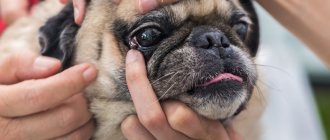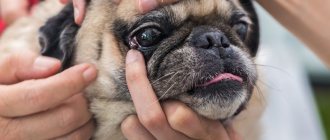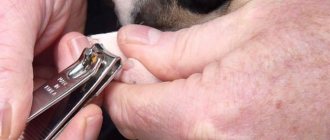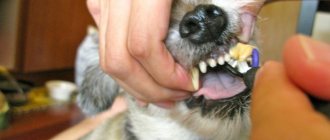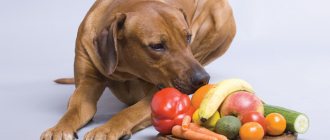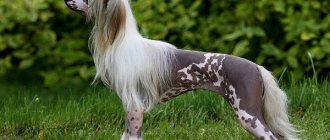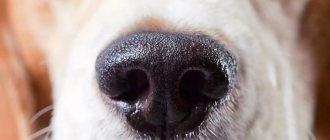Why do you need to rinse your dog's eyes?
In dogs, discharge periodically accumulates in the inner corners of the eyes. Normally, they should be colorless or have a grayish tint. The presence of watery fluid indicates the normal functioning of the lacrimal apparatus, which is necessary to moisturize the cornea and mucous membrane.
Due to the anatomy of their paws, dogs cannot clean their eyes on their own. Therefore, the owner must provide regular care. Washing allows you to avoid suppuration and the development of dangerous infectious diseases. Owners of the following breeds should approach the procedure carefully:
- with large, drooping eyelids;
- with bulging eyeballs;
- with a brachycephalic head shape;
- with thick and long hair in the eyelid area, on the head.
In addition, with age, pets develop a pronounced dullness of the cornea. This occurs due to a decrease in the production of tear secretion. This feature increases the risk of chronic conjunctivitis, blindness and accumulation of purulent discharge.
Diseases accompanied by lacrimation in dogs
If you are sure that your pet does not have a foreign object in his eye and there has been no trauma, then why are his eyes watering?
The cause of lacrimation can be infectious diseases, inflammatory eye diseases and problems with the tear ducts:
- Lack of exit from the nasolacrimal canaliculus - congenital or acquired as a result of a previous disease.
- Stenosis of the nasolacrimal duct.
- Inflammation in the lacrimal sac, which occurs against the background of narrowing of the nasolacrimal duct.
- Turning of the eyelid inward, causing irritation of the eyeball by eyelashes.
- Blockage of the tear ducts.
- Neoplasms and inflammatory processes in the system that removes tears.
- Allergic reaction to external irritants or food.
- Infectious diseases.
- Conjunctivitis of various etiologies.
- Inflammation of the cornea of the eye - keratitis.
- Inflammation of the vascular network of the eye - uevitis.
- Glaucoma.
All these diseases are quite dangerous for a dog, and untimely and incorrect treatment can not only worsen your pet’s vision, but even completely deprive it of it.
When should you be wary?
Caring for your dog's eyes should be regular; examinations should preferably be carried out weekly, as well as after each long walk through forests or areas with a lot of bushes. You should be wary if purulent discharge of a yellow-green hue appears. They may appear due to the following reasons:
- viral or bacterial infection;
- disruption of eyelash growth and eyelid structure;
- chronic blepharitis, conjunctivitis or keratitis.
In rare cases, excessive tearing is observed with allergies of any nature, ingress of dirt and dust, or injuries to the cornea. The main signs of vision problems in a dog are:
- narrowing of the palpebral fissure;
- very frequent blinking;
- the animal rubs its head with its paws;
- redness of the mucous membrane, burst vessels;
- swelling of the eyelids.
In practice, conjunctivitis is the most common cause of suppuration. This is an inflammation of the outer layer of the eye. Appears against the background of infection, mechanical damage or regular exposure to dirt.
Reasons for appearance
Conjunctivitis in the Yorkshire Terrier can be caused by pathogens. They enter from the external environment onto the surface of the eyeball, protected by the conjunctiva, and penetrate the conjunctival sac. If a dog’s immune system is weakened, an inflammatory process occurs, after which it develops into a complicated disease.
Reasons for the development of conjunctivitis in Yorkies:
- eye damage;
- irritation;
- inflammation of the eyelid and cornea;
- contact with the conjunctiva of dust, fluff, wool, dirt;
- infection;
- burn, frostbite;
- lack of vitamins A, their deficiency;
- the puppy is prone to allergies;
- viruses, fungi;
- Yorkie metabolic disorder;
- arbitrary ingrowth of eyelashes into the eyelid.
Expert opinion
Anna Abramenko
An avid dog lover. Experience in veterinary medicine since 2009.
Ask a Question
Yorkshire terriers are among the dogs at risk for conjunctivitis. It is recommended to carefully monitor the animal’s eyes, check them periodically, perform preventive measures and treat them with special means.
Eye washes
In practice, a variety of solutions are used to wash a dog's eyes. Among them there are ready-made medications, as well as traditional methods. In order not to make a mistake in choosing a solution, it is recommended to consult a veterinarian. An examination by a specialist is required if there is heavy purulent discharge over a long period of time.
Pharmacy solutions
Suitable for the treatment of diseases and regular preventive rinsing. They are sold in regular pharmacies, but before the procedure you need to reduce the dosage, since the anatomy of canines is different from that of humans. Effective solutions:
Sodium chloride
Isotonic solution containing regular salt. Its composition is similar to physiological fluids (plasma, tears). Sold in a dosage of 0.9%, does not require dilution with water. Recommended for regular dog eye care. The advantage is safety for the pet’s body, low price.
Furacilin
Antiseptic solution for the treatment of bacterial eye infections. It is used if it festers, for example, with frequent mechanical damage to the cornea. To create a working solution, mix 20 mg (1 tablet) per 100 ml of clean water. It is advisable to only wipe your eyes with Furacilin.
Chlorhexidine
Antiseptic, sold in human pharmacies in bottles of various sizes. Solution concentration – 0.05%. To treat a dog, it must be diluted with water or saline in a ratio of 1:5 (4 ml per 20 ml of water). Used for instillation, wiping and rinsing.
Ready-to-use washes
Your veterinary clinic or pharmacy sells special eye care products for dogs. They do not require ready-made dilution; the active substance is contained in the optimal dosage for the animal. Usually prescribed for the treatment of eye diseases, after surgery to prevent complications. For example, with blepharoplasty. Effective drugs:
- Diamond eyes. Veterinary antiseptic drops for the treatment and prevention of ophthalmic diseases. The active component is chlorhexidine in reduced concentration.
- Tsiprovet. Antibiotic drops for dogs. The drug is used to treat bacterial conjunctivitis and corneal injuries with severe suppuration.
- Albucid. Drops containing sodium sulfacyl. It has a powerful antimicrobial effect and is recommended for the treatment and prevention of conjunctivitis.
- Tobrex. Antibacterial drops for the treatment of infectious eye diseases and inflammation. The duration of treatment and frequency of use are prescribed by the veterinarian depending on the clinical characteristics.
- Solcoseryl. Therapeutic gel with a regenerating, healing effect. Suitable for treating trauma.
The choice of a specific solution, its dosage and treatment regimen should be made by the attending veterinarian. It is not advisable to treat your dog with Miramistin or any other strong antiseptic yourself without knowing the proportions for preparing the solution.
Folk remedies
Homemade solutions are often used to wash the dog's eyes prophylactically. They are weakly effective, but are completely safe for the pet’s sensitive body. Basic methods:
- Camomile tea. The product has a wound-healing, anti-edematous effect. Relieves inflammation, suitable for removing impurities. To prepare 1 tbsp. l. dry chamomile, pour 200 ml of warm water, let it brew for 20 minutes. Cool before use.
- Tea. For eye care, you can use a weak tea leaves. It removes secretions well, has a mild tonic and anti-inflammatory effect. Rinsing your eyes with tea can be done at any age.
Apply all home remedies directly on the day of preparation. It is strictly forbidden to use them if they turn sour or acquire an unpleasant odor.
Treatment methods
There are several ways to treat conjunctivitis in animals. It all depends on the type, form, neglect and complications of the disease. The procedures can be carried out in natural home conditions, but under the supervision of a doctor.
Drug therapy
To rid your pet of conjunctivitis, treatment is prescribed.
The veterinarian may prescribe for a Yorkie:
- ointments that relieve inflammation;
- antibiotics;
- eye drops;
- medicines for oral use, tablets, mixture.
- vitamins that strengthen the immune system.
Traditional methods
These methods are mainly used by experienced breeders and dog handlers. It is necessary to wipe the Yorkie's eye area and apply lotions on them. You can use one of the solutions for this: tea, calendula, chamomile, eyebright, furatsilin or potassium permanganate. It would be a good idea to inject a few drops of iris oil into your pet's eyes.
How to wash your dog's eyes at home
Clean the dog’s eyes at least once a week, and also increase the intensity of the procedures when there is an active accumulation of secretions. Treatment is carried out using medications; home remedies can also be used for prevention. Before starting work, prepare cotton pads, rinsing agent and treats to reward the dog after manipulation. All movements should be smooth and slow so that the pet does not feel stress or aggression.
Step-by-step algorithm of actions
You need to be careful when using pharmaceutical products. They can cause discomfort and tingling. How to wash your dog's eyes:
- Fix your head and hold your torso tightly. Representatives of small breeds can be wrapped in a blanket or towel.
- Soak a cotton pad in the medicinal solution. Rub your eyes with it, moving from the outer corner to the inner part. Do not put pressure on the eyeball; if it dries out, replace the disc.
- If dried crusts have accumulated, they must first be moistened - with a cotton pad or napkin heavily moistened in the solution, moisten the required area. And then rinse your eyes yourself.
Some products are produced in the form of drops, which makes eye treatment easier. Using two fingers, slightly spread the eyelids and drop the required amount of the drug into the upper corner. Simulate blinking by closing and opening your eyelids with your hands.
If you are using the drug in the form of an ointment, then pull the lower eyelid with your hand and squeeze a small amount onto the mucous membrane. Close your eyelids to blink. Immediately after the procedure, offer the dog a treat to distract the pet from discomfort.
First aid
If it is not possible to take your Yorkshire Terrier to a veterinarian, you must immediately provide him with first aid. To do this, you can resort to treatment methods with folk remedies.
Operating principle:
- Wipe the affected area, remove the pus that has accumulated in the corners of the Yorkie's eye or under it. To do this, you need to take a piece of cotton wool, soak it in tea leaves or strong tea and wipe off the exudate.
- After 10-20 minutes, apply ointment (tetracycline or penicillin) to the inner corner of the Yorkie's eyelid.
The course must be carried out 3-4 times a day for two to three weeks. The dosage and medications are prescribed directly by veterinarians.
Severe irritation can be easily relieved with almond oil, which can be injected into the Yorkie's eye, one drop from a pipette.
Thanks to such actions, the owner will relieve his pet from sharp, painful pain. If you don’t have any medications on hand, you can buy the herb “eyebright” at the pharmacy. Infuse the plant for three hours (1 glass of hot water per 10 g). Wash your eyes with the resulting solution and make lotions (compresses).
Even after first aid, your Yorkie must be taken to a specialist for an examination and then treated for the eyes under the supervision of a veterinarian.
We should not forget that the animal is a carrier of the disease, which can also infect humans. It would be a good idea for the owner of the Yorkie to get checked at the clinic.
What to do in case of emergency
If you notice that the dog is acting restless and scratching its head, and the cornea is inflamed and there is a large amount of pus, then urgent measures need to be taken. Carefully examine the eyes and, if necessary, carefully remove the foreign body. Moisten a cotton pad with saline solution and gently wipe each eye. Contact your veterinarian as soon as possible to determine the cause of the disease and prescribe treatment. Throughout the entire period of therapy, monitor your pet’s behavior and undergo regular scheduled examinations. Report any complications or the appearance of atypical features.
Prevention
To avoid dangerous ophthalmological diseases, suppuration and early clouding of the cornea, simple preventive measures should be followed. Useful tips:
- systematically cleanse the eyes of pus, rinse with chamomile, sterile water or saline;
- when bathing, avoid getting shampoo on the mucous membrane, which can cause irritation of the mucous membrane;
- monitor the length of the hair in the head area, thin out the eyebrows in a timely manner;
- treat chronic diseases, adjust the daily diet taking into account taste preferences, age and physical activity.
Some breeds are recommended to undergo surgery to change the length and area of the eyelids during childhood (Shar Pei, Basset Hound). Blepharoplasty improves your pet's appearance and helps avoid serious problems in the future.
Signs and symptoms
For all types of conjunctivitis, the symptoms are similar:
- redness of the mucous membrane of the eye;
- excessive tearing;
- loss of hair around the eyelids and eyelashes;
- swelling;
- the appearance of purulent or mucous discharge.
When the disease occurs, your Yorkie experiences discomfort and a strong burning sensation (in the eye area). Behaves nervously or passively, often scratches your eyelids with your paw and squints your eyes.
Briefly about the main thing
- Eye discharge in dogs is a natural physiological process. Normally, they should be moderate and transparent.
- Pay attention to suppuration in the cornea area. This may be a symptom of injury, chronic diseases (keratitis, blepharitis, conjunctivitis).
- Pharmaceutical preparations, veterinary solutions and home recipes are used to care for the eyes. Treatment should be selected only by a doctor.
- For prevention and regular care, you can rinse or instill chamomile infusion, sterile water or diluted saline solution.
How often and with what do you wash your dog’s eyes? Share your experience in the comments to the article.
How to treat
What to do if the cause of your dog's lacrimation is related to a disease? If this is a general disease of an infectious nature, then the tears will stop flowing as soon as the underlying disease is cured.
For inflammatory eye diseases - conjunctivitis, uevitis, keratitis, complex treatment is prescribed, including anti-inflammatory, antibacterial drugs, which are applied to the eye in the form of drops or ointments. If necessary, veterinarians recommend additional medications in tablets or injections.
The most popular drugs used to treat conjunctivitis, keratitis, and blepharitis in dogs are veterinary drops - “Tsiprovet”, “Bars”. They contain antibiotics that are active against gram-positive and gram-negative microorganisms and also have an anti-inflammatory effect.
Glaucoma in dogs has practically no treatment, only drugs are prescribed that lower intraocular pressure and alleviate the animal’s condition.
For lacrimation associated with pathologies of the lacrimal system, surgical intervention is most often necessary. During the operation, the patency of narrowed, overgrown or blocked areas is restored, after which tear drainage begins to occur normally.
Watery eyes in a dog suffering from allergies due to poor diet or exposure to external factors will return to normal after the animal’s contact with the allergen stops. Additionally, the doctor may prescribe antihistamines.
To preventively moisturize the surface of a dog’s eye in a dry room, you can use “Diamond Eye” or “Optimmune” drops.
